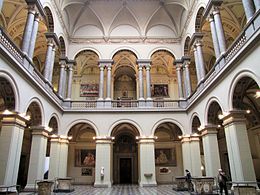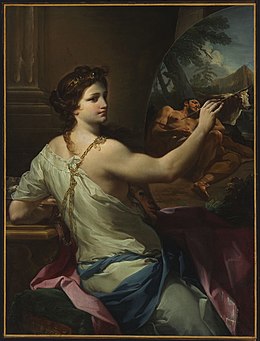Budapest Museum of Fine Arts and Palace of Art
 | |
 | |
| Established | 1906 (1906) |
|---|---|
| Location | Heroes' Square, Budapest |
| Type | Art museum |
| Collection size | 100,000 |
| Manager | László Baán |
| Architect | Albert Schickedanz and Fülöp Herzog |
| Website | www |

The Museum of Fine Arts (Hungarian: Szépművészeti Múzeum [ˈseːpmyveːsɛti ˈmuːzɛum]) is a museum in Heroes' Square, Budapest, Hungary, facing the Palace of Fine art.
Information technology was built by the plans of Albert Schickedanz and Fülöp Herzog in an eclectic-neoclassical style, betwixt 1900 and 1906. The museum's collection is fabricated upward of international art (other than Hungarian), including all periods of European art, and comprises more than 100,000 pieces. The collection is made up of older additions such as those from Buda Castle, the Esterházy and Zichy estates, as well as donations from individual collectors. The Museum'due south drove is fabricated upwards of six departments: Egyptian, Antique, Old sculpture gallery, Quondam master paintings gallery, Modern collection, Graphics collection. The establishment celebrated its centenary in 2006.
Drove and exhibits [edit]
Ancient Egyptian art [edit]
The gallery holds the 2d largest collection of Egyptian art in central Europe.[ citation needed ] It comprises a number of collections bought together by Hungarian Egyptologist, Eduard Mahler, in the 1930s. Subsequent digs in Egypt have expanded the collection. Some of the most interesting pieces are the painted mummy sarcophagi.
Classical antiquities [edit]
The core of the collection was fabricated up of pieces caused from Paul Arndt, a classicist from Munich. The exhibition mainly includes works from Ancient Hellenic republic and Rome. Most significant is the 3rd century marble statue called the Budapest dancer. The Cyprean and Mycenaean collection is likewise notable, besides the ceramics and bronzes.
Quondam chief paintings (13th to 18th centuries) [edit]
The 3000 paintings in the collection offer an almost uninterrupted survey of the development of European painting from the 13th to the late 18th centuries. The cadre of the collection is constituted by the 700 paintings caused from the Esterhazy estate. The collection is separate into Italian, High german, Netherlandish, Flemish, French, English language and Spanish art. The most important works include Maso di Banco's Coronation of the Virgin, Sassetta's Saint Thomas Aquinas at Prayer, Domenico Ghirlandaio's Saint Stephen Martyr, Bernardo Bellotto's The Piazza della Signoria in Florence, Gentile Bellini'southward Portrait of Caterina Cornaro, Giorgione's Portrait of a Young man, Raphael's Esterhazy Madonna, Giambattista Pittoni'southward St Elizabeth Distributing Alms, iii works by Corrado Giaquinto, Allegory of Painting, The Angel Annunciant and Moses receiving the Laws, Correggio'southward Madonna and Child with an Angel, three works by Sebastiano del Piombo, Bronzino'south Adoration of the Shepherds as well as his Venus, Cupid and Jealousy, Romanino's Doge Agostino Barbarigo Handing over a Banner to Niccolo Orsini, Titian'southward Portrait of Doge Marcantonio Trevisani, Tintoretto'southward Supper at Emmaus, Tiepolo'due south St James the Greater in the Battle of Clavijo, Dürer's Portrait of a Young man, Bernard van Orley'south Portrait of Emperor Charles Five, 8 pictures past Lucas Cranach the Elder, Pieter Bruegel the Elderberry's St John the Baptist Preaching, Rubens's Mucius Scaevola Before Porsenna, Murillo'southward The Christ Child Distributing Breadstuff to Pilgrims, Maarten van Heemskerck'south Lamentation, two excellent portraits by Frans Hals, and a particularly strong drove of works by Spanish masters including El Greco, Velázquez and Goya.


Old sculpture [edit]
The collection's master section is devoted to pieces from the Center Ages to the 17th century. Information technology was based on the Italian collection of Karoly Pulszky and Istvan Ferenczy's bronze collections. From the latter came one of the nigh treasured works, the small-scale equestrian by Leonardo da Vinci. A number of painted wooden sculptures feature in the German and Austrian section.
Drawings and prints [edit]
The collection shows selected rotating exhibitions of its collection of 10,000 drawings and 100,000 prints originating mainly from the Esterhazy, Istvan Delhaes and Pal Majovsky acquisitions. All periods of European graphic art are represented. Of import pieces include two studies by Leonardo da Vinci for the Boxing of Anghiari, 15 drawings by Rembrandt, 200 pieces past Goya, and French aquatints.
Art after 1800 [edit]

One of the halls in the museum



The museum's collection of 19th- and 20th-century art is less significant than those found in other departments; it is a younger collection. The bulk of the painting is from the Biedermeier menstruum and French art. From the latter are representatives of the Romantic period (Eugène Delacroix), the Barbizon school (Jean-Baptiste-Camille Corot, Gustave Courbet) and Impressionism (Édouard Manet, Claude Monet, Camille Pissarro, Pierre-Auguste Renoir, Henri de Toulouse-Lautrec). There is a large collection of sculptures by Auguste Rodin and Constantin Meunier.
Vasarely Museum [edit]
Hungarian artist, Victor Vasarely, donated a pregnant collection of his works to the gallery. These have establish a permanent home outside the walls of the gallery at the Zichy mansion in Óbuda. The two-storey wing of the building is known as the Vasarely Museum and is the only i of its kind in eastern Europe.
Directors of the museum [edit]
- 1906–1914 Ernő Kammerer
- 1914–1935 Elek Petrovics
- 1935–1944 Dénes Csánky
- 1949–1952 Imre Oltványi
- 1952–1955 Ferenc Redő
- 1956–1964 Andor Pigler
- 1964–1984 Klára Garas
- 1984–1989 Ferenc Merényi
- 1989–2004 Miklós Mojzer
- 2004– László Baán
Budapest Museum Quarter project [edit]
In 2008, the director of the Museum of Fine Arts, László Baán, proposed the merging of his museum with that of the Hungarian National Gallery, due to the similar exhibition and collection profile of the two. Both (forth with the Ludwig Museum of Contemporary Art) specialize in 20th century and contemporary fine fine art, much of which was created by Hungarian artists living overseas.[1] Afterwards his request to add an €18million underground extension to the Museum of Fine Arts, which would have united collections spread across the metropolis, was denied in February 2011, Baán presented an culling plan to the government to build two new buildings at the cost of €150m. He envisioned the new buildings, one housing contemporary European art and the other Hungarian photography, as a "special museum isle" that would complement the Museum of Fine Arts and the Budapest Art Hall (Műcsarnok) by permanently joining the ii collections past 2017.[2]
In September 2011, Secretary of State for Civilization Géza Szőcs officially appear plans to build a new structure forth Andrássy út close to City Park and near the existing Budapest Museum of Fine Arts and Budapest Art Hall (Műcsarnok). This edifice would house the collections of the current Hungarian National Gallery.[3] This expanded plan, which would utilize the entire boulevard, is also referred to as the Budapest Museum Quarter or Andrássy Quarter.[4]
In early on Dec 2011, Ferenc Csák, director of the Hungarian National Gallery since 2010 and critical of the proposed merger of the gallery with the Museum of Fine Arts, chosen the merge process "[v]ery unprofessional, anti–autonomous and brusque–sighted" and announced that he would resign at the terminate of 2011.[5] As of 5 March 2012[update], a new director had not been named and the Hungarian National Gallery was existence led by Deputy General Director, György Szűcs.[6]
See likewise [edit]
- Budapest Kunsthalle (Palace of Art) — contemporary art museum across the square.
- Hungarian National Gallery
- Listing of museums in Hungary
- Museums in Budapest
References [edit]
- ^ Mélyi, József (three November 2010). "Notes for a Budapest Museum Master Plan". Art Margins Online. Archived from the original on 27 June 2011. Retrieved 2 Feb 2012.
- ^ Unwin, Richard (iii August 2011). "Budapest director'southward double vision for national museum". The Art Newspaper. Archived from the original on 12 January 2012. Retrieved iv August 2016.
- ^ MTI (iii October 2011). "Government commissioner appointed for planned "museum quarter" in Budapest". Realdeal.hu. Archived from the original on 6 October 2011. Retrieved 4 August 2016.
- ^ Földes, András (15 September 2011). "Houdini-cirkusz es fiákerek az Andrássyn". index.hu . Retrieved 29 February 2012.
- ^ Unwin, Richard (7 December 2011). "Hungarian national gallery director resigns in protestation". The Art Newspaper. Archived from the original on 27 March 2012. Retrieved 4 August 2016.
- ^ "Contact". Hungarian National Gallery. Archived from the original on 28 February 2012. Retrieved five March 2012.
Further reading [edit]
- John Charles Van Dyke (1914), Vienna, Budapest: critical notes on the Purple Gallery and Budapest Museum, New York: C. Scribner'southward Sons, OL 23356514M
- The Budapest Museum of Fine Arts. Edited and with a preface by Klára Garas. Corvina, 1990.
- S. Urbach, Early Netherlandish Painting in Budapest: Volume I (= Distinguished Contributions to the Study of the Arts in the Burgundian Netherlands 1. 1), Turnhout: Harvey Miller, 2015, ISBN 978-ane-909400-09-2
- Due south. Urbach, Early Netherlandish Painting in Budapest: Book II (= Distinguished Contributions to the Study of the Arts in the Burgundian Netherlands 1. 2), Turnhout: Harvey Miller, 2015, ISBN 978-one-909400-29-0
External links [edit]
- (in English) Museum website
- (in English) Museum.hu information
- Aerial photographs of the museum
Coordinates: 47°30′58″N 19°04′35″E / 47.51611°N 19.07639°E / 47.51611; nineteen.07639
Source: https://en.wikipedia.org/wiki/Museum_of_Fine_Arts_%28Budapest%29
0 Response to "Budapest Museum of Fine Arts and Palace of Art"
Post a Comment